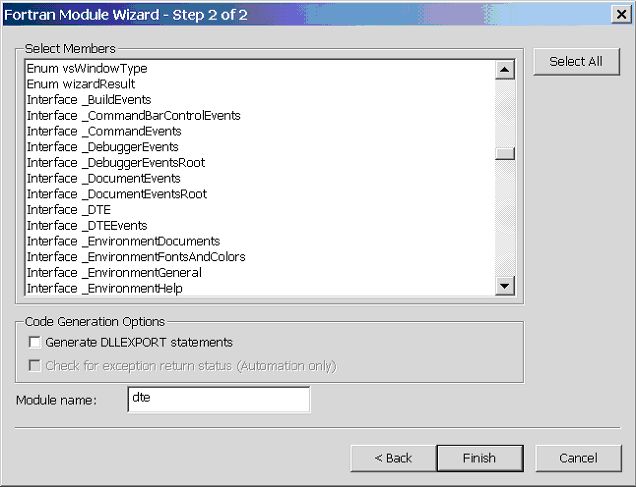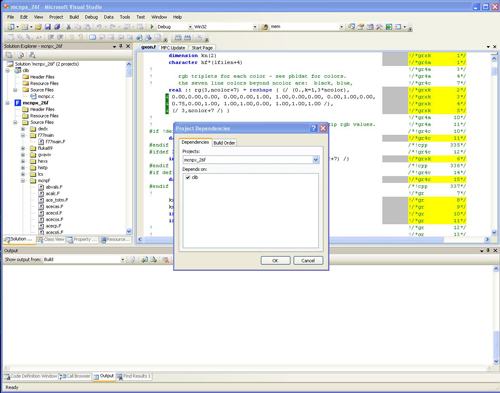

- #How to create a dialog in intel visual fortran how to#
- #How to create a dialog in intel visual fortran 64 Bit#
- #How to create a dialog in intel visual fortran code#
- #How to create a dialog in intel visual fortran plus#
- #How to create a dialog in intel visual fortran windows#
The problem is that SALFORD does not support

We have a transport model developed over the years using SALFORDįORTRAN and recently decided to parallelise it to take advantage of Has anyone got some experience in linking Intel Visual Fortran (IVF) Posted: Tue 10:01 pm Post subject: Linking Intel Visual Fortran Object Files/DLLs in FTN95 Linking Intel Visual Fortran Object Files/DLLs in FTN95 Profile Log in to check your private messages Log in "Fortran Files"//C_NULL_CHAR//"*.f90 *. :: View topic - Linking Intel Visual Fortran Object Files/DLLs in FTN95įAQ Search Memberlist Usergroups Register Type(OPENFILENAME_T), intent(INOUT) :: Arg1Ĭharacter(100), target :: filter_spec = &

!DIR$ ATTRIBUTES STDCALL :: GetOpenFileName program GetFileįunction GetOpenFileName (Arg1) bind(C,name="GetOpenFileNameA") (Earlier versions have a bug that make the filters not work on 圆4.) Even with my declaring the large data structure, it’s only 76 lines.
#How to create a dialog in intel visual fortran 64 Bit#
I have tested this using Intel Fortran 2020 Update 4 for both 32 and 64 bit targets.
#How to create a dialog in intel visual fortran plus#
means needing a second install, plus creating a way to get the information to and from the external language.Įven if you wanted to create a full-blown Windowing application, there are Fortran libraries available (free and paid) to make it easier.įWIW, I rewrote the Intel example to be self-contained and Fortran 2018-compliant (except for the one line of directive).
#How to create a dialog in intel visual fortran windows#
I do not agree that calling Python or Tcl is any less of a hassle than the 30-odd (not 100) lines it takes to use the Windows API.
#How to create a dialog in intel visual fortran how to#
! Example of how to see if user said "Read Only" Type *,'Filespec is ',file_spec(1:ilen-1) ! Get length of file_spec by looking for trailing NUL Ofn%lpstrInitialDir = NULL ! Use Windows default directory Ofn%nFilterIndex = 1 ! Specifies initial filter value Ofn%hInstance = NULL ! For Win32 applications, you ! Initialize with an initial filespec, if any - null string ! Declare string variable to return the file specification. The list ends with a trailingĬharacter(*),parameter :: filter_spec = & ! is the file type name, the second is a semicolon-separated list Implicit none ! Declare structure used to pass and receive attributes ! PURPOSE, NON-INFRINGEMENT OF INTELLECTUAL PROPERTY RIGHTS. ! NOT LIMITED TO ANY IMPLIED WARRANTY OF MERCHANTABILITY, FITNESS FOR A PARTICULAR ! THIS FILE IS PROVIDED “AS IS” WITH NO WARRANTIES, EXPRESS OR IMPLIED, INCLUDING BUT
#How to create a dialog in intel visual fortran code#
! SAMPLE SOURCE CODE - SUBJECT TO THE TERMS OF SAMPLE CODE LICENSE AGREEMENT, Here is the complete Intel code sample (I can’t get the whole thing to format as code): (Visual Studio is also not required to use the Windows API.) The code sample from requires some modules (Constant and Toolbar) that they must have created themselves, as those are not part of Intel Fortran. All that is necessary is a compiler that supports the STDCALL calling mechanism (on 32-bit only, not an issue on 64-bit), a declaration of the appropriate derived type, and linking against comdlg32.lib (part of the Windows SDK). It does, however, include predefined declarations that make it easier. I even got asked if I could improve the code/user experience further for Intel Fortran is not required to use the Windows API routines. The purpose of the program was to measure the surface tension of a liquid drop from a set of images and produce a small text report. As soon as I added the file selection dialog box, they found it much more convincing and easier to use. In the first iteration of the program I had a command-line interface, but the users (fellow scientists and master students), were not that happy to work with it. Recently, I did a project in MATLAB where I used the uigetfile function (“Open file selection dialog box”). While it might be difficult to get it to work across operating systems, a simple file dialog can be a very effective way to bring a program closer to the users.


 0 kommentar(er)
0 kommentar(er)
